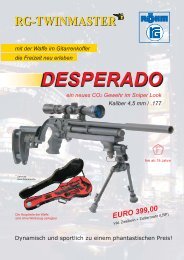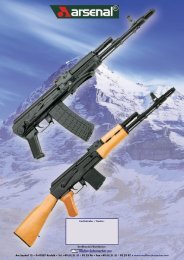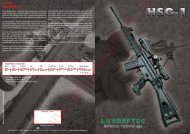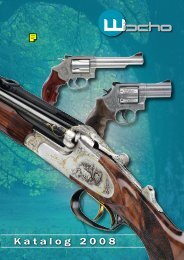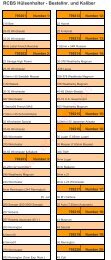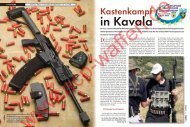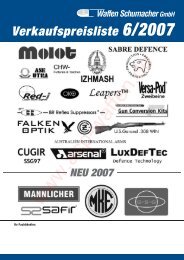firearms, ammunition and accessories - ACP-Waffen
firearms, ammunition and accessories - ACP-Waffen
firearms, ammunition and accessories - ACP-Waffen
Create successful ePaper yourself
Turn your PDF publications into a flip-book with our unique Google optimized e-Paper software.
CENTERFIRE BALLISTICS<br />
Finding the correct <strong>ammunition</strong> <strong>and</strong> underst<strong>and</strong>ing how it<br />
performs is key to not only getting the most out of your rifle, but<br />
for safety’s sake as well. To help you better underst<strong>and</strong> centerfire<br />
ballistics, Remington has compiled a series of tables to make it<br />
easy to identify the proper <strong>ammunition</strong> <strong>and</strong> to measure its performance<br />
through velocity, energy <strong>and</strong> trajectory.<br />
RIFLE VELOCITY VS BARREL LENGTH.<br />
These tables were calculated by computer. A st<strong>and</strong>ard scientific technique<br />
was used to predict trajectories from the best available data for each round.<br />
Trajectories shown typify the <strong>ammunition</strong>’s performance at sea level, but note<br />
that they may vary due to atmospheric conditions <strong>and</strong> the equipment.<br />
All velocity <strong>and</strong> energy figures in these charts have been derived by using<br />
test barrels of indicated lengths.<br />
Ballistics shown are for 24" barrels, except those for 30 carbine <strong>and</strong><br />
44 Remington Magnum, which are for 20" barrels. These barrel lengths<br />
were chosen as representative, as it’s impractical to show performance<br />
figures for all barrel lengths.<br />
The muzzle velocities, muzzle energies <strong>and</strong> trajectory data in these tables<br />
represent the approximate performance expected of each specified loading.<br />
Differences in barrel lengths, internal firearm dimensions, temperature <strong>and</strong> test<br />
procedure can produce actual velocities that vary from those given here.<br />
R IMFIRE<br />
22 W.R.F.<br />
22 Remington Special<br />
22 Win. Model 1890 in a 22 Win. Mag.<br />
Rimfire but not conversely<br />
C ENTERFIRE<br />
25-20 Remington<br />
25-20 W.C.F.<br />
25-20 Win.<br />
25-20 Win. High Speed<br />
25-20 Marlin<br />
25 W.C.F.<br />
6mm Rem.<br />
244 Remington<br />
25 Automatic<br />
25 Auto. Colt Pistol (<strong>ACP</strong>)<br />
25 (6.35mm) Automatic<br />
6.35mm Browning<br />
7mm Express ® Remington<br />
280 Remington<br />
C ENTERFIRE ( CONT.)<br />
30-30 Sav.<br />
30-30 Win.<br />
30-30 Win. Accelerator* (SEE NOTE A)<br />
30-30 Marlin<br />
30-30 Win. High Speed<br />
30 W.C.F.<br />
32 Colt Automatic<br />
32 Auto. Colt Pistol (<strong>ACP</strong>)<br />
32 (7.65mm) Automatic<br />
7.65mm Automatic Pistol<br />
7.65mm Browning (not interchangeable<br />
with 7.65mm Luger)<br />
32 Short Colt in 32 Long Colt<br />
but not conversely<br />
(SEE NOTE C)<br />
32 S&W in 32 S&W Long<br />
but not conversely<br />
32 S&W Long<br />
32 Colt New Police<br />
32 Colt Police Positive<br />
1. Determine how much shorter, or longer, your barrel is than the test barrel.<br />
2. In the left column of the chart (left), select the muzzle-velocity class<br />
of your cartridge.<br />
3. To the right of that class, read the approximate change in velocity<br />
per inch of barrel length.<br />
4. Multiply this number by the difference in the length of your barrel<br />
from that of the test barrel.<br />
5. If your barrel is shorter than the test barrel, subtract this figure<br />
from the muzzle velocity shown for your cartridge.<br />
6. If your barrel is longer, add this figure to the muzzle velocity shown.<br />
The trajectory figures shown in these ballistic tables are the rise or drop, in<br />
inches, of the bullet from a direct line of sight at selected yardage. Sighting-in<br />
distances have been set at 100 to 250 yards.<br />
The line of sight used is 1 1 ⁄2" above the axis of the bore. Since the rise or<br />
drop figures shown at the stated yardage are points of impact, you must hold<br />
low for positive figures, high for negative figures.<br />
Many shooters who use the same cartridge often find it helpful to commit<br />
the rise <strong>and</strong> drop figures for that cartridge to memory, or tape them to their<br />
rifle stock. That way, they know instantly the right “hold” as soon as they<br />
estimate the target’s range.<br />
VENTED TEST BARREL BALLISTICS.<br />
This Remington ® -patented, industry-accepted method provides data<br />
that more precisely reflect actual use of revolver <strong>ammunition</strong>. It considers<br />
cylinder gap, barrel length, powder position, <strong>and</strong> production tolerances.<br />
Although our final values differ from conventional figures, the <strong>ammunition</strong><br />
is unchanged. Key elements of our patented procedure include: (a) horizontal<br />
powder orientation; (b) cylinder gap: .008"; (c) barrel length: 4".<br />
INTERCHANGEABILITY CHART<br />
Cartridges within groups shown are interchangeable. Other substitutions should not be made without specific recommendation of the <strong>firearms</strong> manufacturer since<br />
improper combinations could result in firearm damage or personal injury.<br />
78<br />
CENTERFIRE RIFLE VELOCITY VS. BARREL LENGTH<br />
MUZZLE VELOCITY APPROX. CHANGE IN MUZZLE VELOCITY<br />
RANGE (FT./SEC.) PER 1" CHANGE IN BARREL LENGTH (FT./SEC.)<br />
2000-2500 10<br />
2500-3000 20<br />
3000-3500 30<br />
3500-4000 40<br />
NOTE A: High-speed cartridges must not be used in revolvers. They should be used only in rifles<br />
made especially for them.<br />
NOTE B: Ammunition with “+P” on the case headstamp is loaded to higher pressure. Use only<br />
in <strong>firearms</strong> designated for this cartridge <strong>and</strong> so recommended by the gun manufacturer.<br />
NOTE C: Not for use in revolvers chambered for 32 S&W or 32 S&W Long.<br />
C ENTERFIRE ( CONT.)<br />
32 W.C.F. (SEE NOTE A)<br />
32 Win. (SEE NOTE A)<br />
32-20 Win. High Speed (SEE NOTE A)<br />
32-20 Colt L.M.R<br />
32-20 W.C.F (SEE NOTE G)<br />
32-20 Win. <strong>and</strong> Marlin<br />
38 S&W<br />
38 Colt New Police<br />
380 Webley<br />
38 Colt Special<br />
38 S&W Special<br />
38 Special Targetmaster®<br />
38 S&W Special Mid-Range (SEE NOTE D)<br />
38 Special +P (SEE NOTE B)<br />
38-44 Special +P (SEE NOTE B)<br />
38 Special<br />
38 Special Flat Point<br />
38 Short Colt in 38 Long Colt but not<br />
conversely. Both can be used in 38 Special<br />
38 Marlin<br />
38 Win. (SEE NOTE A)<br />
C ENTERFIRE ( CONT.)<br />
38 Remington (SEE NOTE A)<br />
38-40 Win.<br />
38 W.C.F. (SEE NOTE A)<br />
38 Automatic in 38 Super +P<br />
but not conversely<br />
380 Automatic<br />
9mm Browning Short (Corto Kurz)<br />
9mm Luger (SEE NOTE E)<br />
9mm Parabellum<br />
44 S&W Special (SEE NOTE F)<br />
44 Marlin<br />
44 Win.<br />
44 Remington<br />
44-40 Win.<br />
44 W.C.F.<br />
45-70 Government<br />
45-70 Marlin, Win.<br />
45-70-405<br />
NOTE D: All 38 Special cartridges can be used in 357 Magnum revolvers but not conversely.<br />
NOTE E: 9mm sub machine gun cartridges should not be used in h<strong>and</strong>guns.<br />
NOTE F: 44 Russian <strong>and</strong> 44 S&W Special can be used in 44 Remington Magnum revolvers<br />
but not conversely.<br />
NOTE G: Not to be used in Win. M-66 <strong>and</strong> M-73.



